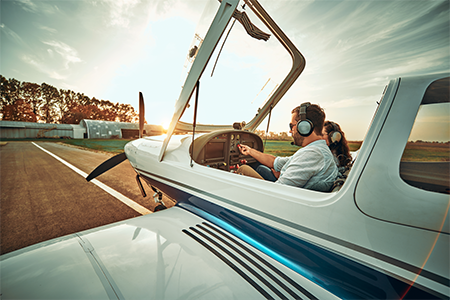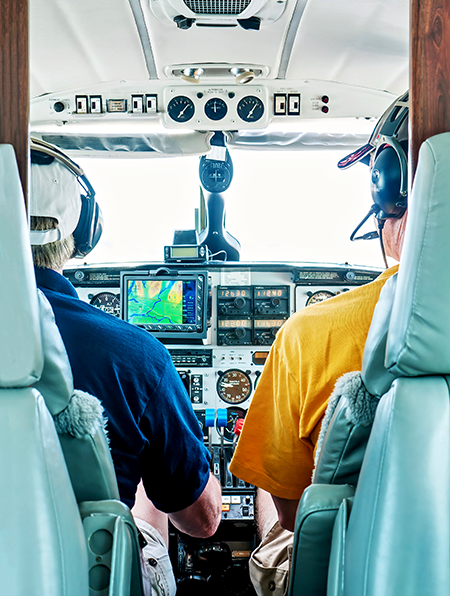“They were an accident waiting to happen” is a regular comment made to CAA’s fatal accident investigators.
“It makes really quite sad reading,” says CAA Safety Investigator Colin Grounsell, of a document sent to him, detailing the lead-up to a recent fatal flight.
The document was put together by a senior instructor, outlining the deceased pilot's history and the attempts made to alter his approach to safety.
Colin says, “It appears he had been known quite widely for unsafe flying. And there had been attempts by fellow pilots – and clubs – to guide him into safer flying.
“I guess everybody hoped they could change his decision-making, but in the end, sadly, they couldn’t.”
The document’s author says he, and his fellow instructors, have to keep their finger on the pulse of what’s happening at their organisations.
“Sometimes, a pilot regularly infringes safety because they’re failing to appreciate their own lack of knowledge – often of conditions – or skill in managing those conditions with appropriate margins for safety.
“But you have some influence over someone in their biennial flight review. Don't conduct just a 20-minute flight – if you and others have had concerns, make it an hour, or two hours. Challenge them, don't make it just a box tick.
“Sometimes it’s hard to understand what challenges some pilots have, without a thorough BFR. This can be true for both low-hour pilots, and those who’ve reached the later years of their flying careers.
“Hence the importance of standards within organisations, and good assessment procedures.”
The instructor suggests that pilots, worried about the flying of a colleague, but unwilling to speak to them themselves, could tell a duty instructor.
“And, if nothing happens, you could approach the CFI.
“But the best way, probably, is to talk to them yourself.”
How to approach

Photo: iStock.com/Harbucks
It’s never easy, however, to try to influence a fellow pilot’s flying, says CAA Safety Investigator Lou Child. “But it can be done in roundabout ways.
“Flying communities are quite tight. You could perhaps approach someone you know is a friend of the pilot concerned, and say, ‘Hey, you’re a good mate of theirs, how do you feel about talking to them about this? We’ve seen this and think they might need a bit of help. You might think the same thing’.
“Or maybe you go flying with them, and talk about what’s happening and why it’s happening, during the flight.
“So, getting the message through may be difficult but can be done, especially through connections.”
In handling a non-responsive pilot, Nelson Aviation College Safety Officer, Jackie Day, called on CAA Aviation Safety Advisor Carlton Campbell to talk to them.
“This pilot really respected Carlton so he did respond to Carlton’s intervention,” she says.
And even an innovative approach could work. Some years ago, when he was safety officer for a flying organisation, the senior instructor, highlighted earlier, observed a Part 149 pilot using an inadequate homemade wooden seat in his aircraft.
“I realised the safety risk of this seat, so I just jumped on it and broke it! Just recently I met that pilot at a reunion. He told me that, once he’d stopped being angry, he really respected me for what I’d done.
“He realised it was better I broke it on the ground, than it broke mid-flight.”
Reluctance to dob in a mate
Saying something, either to the pilot concerned, or about them to someone else, can feel uncomfortable, confronting, and daunting, says CAA Chief Advisor of Human Factors, Alaska White.
“But try thinking about what you want to do in a different way – so, from ‘dobbing in a mate’ to what it really is, which is expressing care and concern for someone else’s safety and wellbeing.”
The senior instructor, who wrote the document about more intervention in poor flying, says people should not worry about ‘dobbing in a mate’.
“I’d rather dob someone in – even if that puts a friendship on the line – than have them involved in a fatal, when I had done nothing to prevent that.”
We should have done something
Flight Examiner Willie Sage told Vector that some years ago, a line pilot of his acquaintance was involved in a fatal CFIT accident.
The general manager who’d been employing that pilot observed, after the accident, that he’d had problems with the pilot and was about to take them offline.
“I wish I had,” he said to Willie, who says that comment has stayed with him ever since.
Willie told the aviation YouTube™ channel Kiwi Tales, that over the years, he’s been in charge of a lot of people and has had the responsibility of deciding whether or not they should go flying.
“If you have that gut feeling that you’re not happy about someone, or you’re worried, you’ve got to act on it.
“It’s no good thinking, ‘Oh yeah, that guy had issues, we should have done something about that’.”
Jackie Day has a similar regret. Some years ago, a convoy of visiting pilots caused “a bit of havoc” as they joined at Motueka.
“It was clear they weren’t prepared for landing at Motueka, but I didn’t say anything because I remember just being thankful that everybody had got on the ground safely, including our students.
“Eventually the convoy left but ended up having an accident at another aerodrome. And I kind of wonder to this day if I could have prevented that, by having a chat with them. Maybe it might have encouraged somebody to think twice about what they were about to do and kept them safe in the long run.”
So how do you say this?

Photo: iStock.com/Cheryl Ramalho
North Shore Aero Club CFI, Daryl Gillett, says pilots who repeatedly push the margins of safety are a “huge issue”.
But when he has to deal with such a pilot, he takes an educational approach.
“Most people are naturally defensive if someone corrects them, even gently, about their flying.
“But you can avoid that reaction if you couch the ‘correction’ as information. Maybe objectively dissect what's happening, like, ‘I noticed you turned to the right after take-off. I’m wondering why you did that? To be safe, it’s really important we make left-hand turns because...’.
“Then they understand the reason for the advice, and that it’s more about education than ‘you broke the rules, and you’re going to be penalised’.
“If you’re aggressive and threatening, or voicing ‘I think you…’ type opinions, you’ll almost certainly fail to resolve the issue, and the other pilot will be reluctant to listen to advice in future.”
Jackie Day takes the same educational approach.
“It’s really important to get all the information you can first, before you start talking to a pilot about their flying.
“And it’s important those questions are asked in a non-confrontational way, like, ‘What do you think happened out there? What was going on for you guys?’”
Jackie gives this illustration of getting information first.
“A pilot joined our circuit when it was really busy. They cut off a few aircraft, had quite a close call, and they made some very poor radio calls.
“And I did go over to talk to them, to find out as much as I could first. It turns out they’d actually had an engine failure and their passenger was trying to make the radio calls, while the pilot was desperately aviating the aircraft to the ground.
“This is just a one-off, of course, but it shows how you don’t know what’s going on with people if you don’t gather your information first.”
Alaska White has other tips.
“Try explaining why you feel the way you do about their flying. Or get them thinking beyond themselves – hit them with some ‘home truths’ about the effect on family, friends, and fellow pilots, if something terrible were to happen to them.
“Make any alternative to continuing the flight that you come up with, beneficial to them. Like asking, ‘What’s the rush? Wait it out because it’s better to get there safe and unharmed’.”
Alaska says there’s “power in numbers”.
“We often think of peer pressure as a bad thing, but a number of people voicing their concerns can be effective in getting someone to change their mind about flying in poor conditions.
“Or you could try calmly asking the person to explain their decision and the reasoning behind it. When they have to explain themselves out loud, often people come to appreciate the reality of what they plan to do.”
When they won’t listen
Some fatal accident reports in the CAA’s archives illustrate how sometimes fellow pilots have tried to intervene, say, with an offer of a bed for the night (VFR into IMC) or directly observing to the pilot concerned how dangerous a particular manoeuvre they just carried out was.
But, tragically, the recipient of that advice and help has sometimes just been determined to do it their way.
“You can’t chain someone to a post and force them to stay on the ground,” says Alaska White.
“At the end of the day, people will do what they want to do and what they think is right for them at the time.
“But it’s better to say something and try to persuade a pilot of a different course of action, than to wish you had.”
CAA intervention
It’s easier for an aero club or flying school to prevent someone flying, if that person needs to hire an aircraft. This has happened, and the occasional flying school has been known to terminate a student’s training contract for repeated poor flying.
But if nothing seems to be working, contacting the CAA is an option – some would say the last option. And to be clear, that doesn’t mean the CAA will respond with punitive action.
In fact, the flight examiners who’re part of the CAA’s licensing and standards team have had real success in mentoring pilots who’ve previously been struggling to fly safely.
“In one particular case, we saw repeated occurrence reports coming through, including from Airways, about one pilot,” says Lou Child.
“So our licensing and standards team rallied, and acting proactively, did some one-on-one mentoring of the pilot concerned.
“It turned out the pilot wasn’t deliberately flying unsafely, but had learning needs that, once understood, were mitigated with a different form of instruction.
“That was a real success. We no longer have any reports of unsafe flying or rules breaches by that pilot.”
